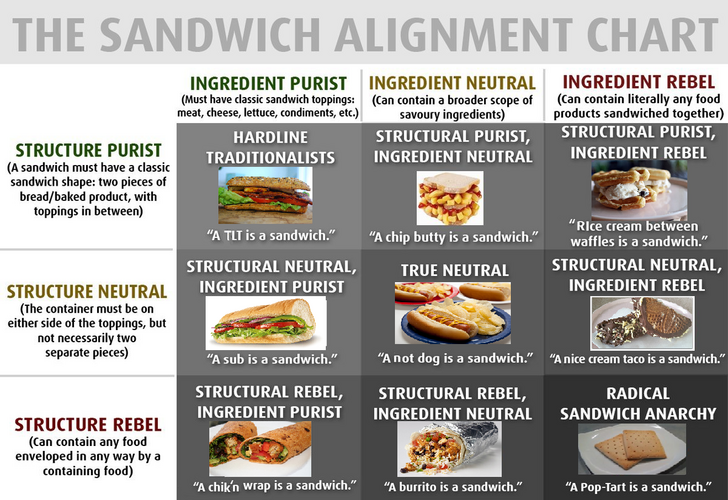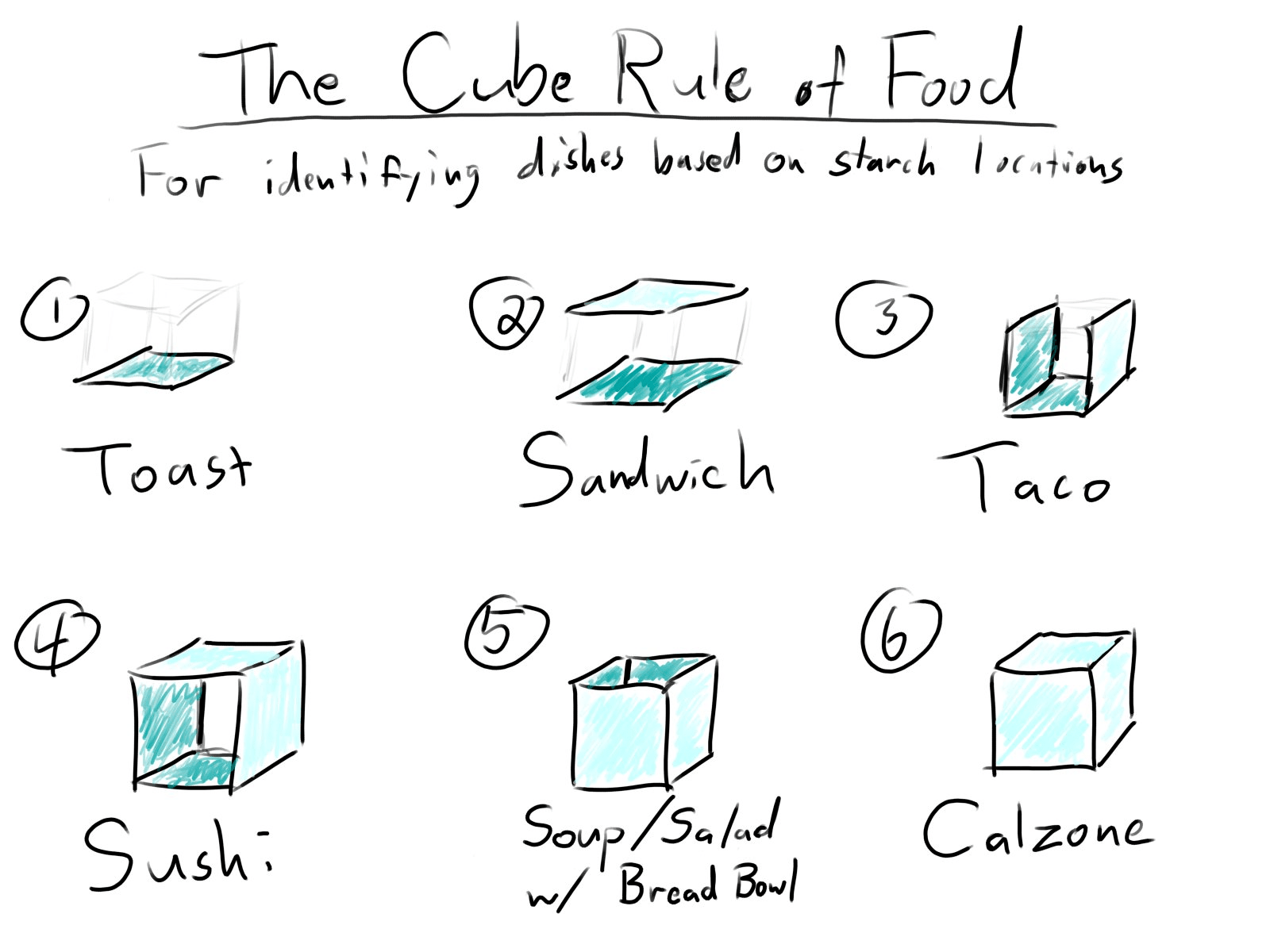Dish Taxonomy
Foreward
Is a hotdog a sandwich?
You've probably heard this question on the internet, or maybe when you were in school.
My coworker asked me this in 2018 and the rest of that afternoon--and ensuing 14 months--were dedicated to discovering whether a hotdog was (or was not) a sandwich, and how to categorize other foods in a taxonomy of dishes.
I'd like to lay out some preliminary solutions to that question, and provide my own framework for classifying what a dish is.
Someone's gotta do it.
Origins
In 1977 TSR Inc. published the original Dungeons & Dragons Basic Set. It included the first alignment chart organized by axes of law and chaos and good and evil. These axes create nine potential alignments that could be used to ascribe a moral and ideological standing for a character, city, or beast in a pen and paper Dungeons & Dragons game.
The Meme

The New York State Department of Taxation and Finance asserts that hot dogs are sandwiches (and thus require a sales tax), much to the chagrin of Twitter users everywhere.
A Dungeons & Dragons style alignment chart of foods appeared sometime thereafter, created by Twitter user @matttomic.
The chart aimed to outline a basic theory of dish organization and introduces nine general categories of food along the axis of sandwich construction.
The chart ranges from hardline traditionalist sandwich construction (BLT) to radical sandwich anarchy (Poptart).
The Sequel

Later, Twitter user @Phosphatide introduced “The Cube Rule of Food Identification.” The basic premise of this rule is that the location of the starch in the dish relative to the cube model determines how the dish is categorized.
A lack of starch, however, is used as a catch-all for anything without.
The result is a starchless category that contains a significantly larger number of dishes than any other category.
There are two primary issues I’d like to attempt to rectify with the cube rule.
- The lack of a starch codifies the dish as a salad. This is problematic because steak, chocolate, and soup are very different dishes that are very much NOT salads.
- The cake classification (added later) requires that the cube is bisected to accommodate a stacked dish.
The Spectrum
 At the extreme ends of the spectrum are sandwiches, soups, and salads. While there are perfect soups, salads, and sandwiches, they are exceedingly rare, and the majority of dishes lie within the spectrum of dish organization.
At the extreme ends of the spectrum are sandwiches, soups, and salads. While there are perfect soups, salads, and sandwiches, they are exceedingly rare, and the majority of dishes lie within the spectrum of dish organization.
Each point of the spectrum is defined as follows:
Ingredient
A single nutritious item. The center of the spectrum and the point at which all dishes begin.Sandwich
Dissimilar ingredients combined and organized in a structure. One ingredient supports, envelops, or surrounds another. Solid at room temperature.Soup
Dissimilar ingredients combined in an unorganized structure. Liquid at room temperature, and the majority ingredient is a fluid.Salad
Dissimilar ingredients combined in an organized structure. Solid at room temperature, the majority of ingredients being solid.The Rules
All dishes are comprised of ingredients. Combining ingredients deviates the category of a dish to one end of the spectrum from the center where all ingredients start.
Combining multiple instances of the same ingredient does not constitute a dish. (Three pieces of bread, a sandwich does not make. )
A dish's category is determined by how the dish is served and is not dynamic before during or after consumption. Tearing apart a sandwich does not turn it into a salad, you've just destroyed a sandwich.
Categories and Intermediaries
A combination of ingredients has an emergent property of a category. Primary categories are described above (soup, salad, sandwich) while intermediary categories serve as a convenience for discussion. Examples of intermediary categories are as follows:
- Stew: Halfway between a soup and a salad
- Pizza: Halfway between a salad and a sandwich
- Wellington: Halfway between a sandwich and a soup
Examples
Below is a list of examples to assist in arguing help further understand the spectrum.
Salt

Taco

PopTart

Boeuf Bourguignon

Tomato Bisque

Is a hotdog a sandwich?
My answer to that, is that it's more sandwich than anything else!
Acknowledgements
Cherie Saffold - for putting up with my bullshit
Isaac Wuest - for helping me stretch this to its limits
Jacob Wiser - for showing me how to organize and present my argument
Simeon Prieskorn - for indulging and supporting
Matt Walker - for the healthy skepticism and pro sandwich rhetoric
Matt Suitt - for helping me realize that I could be passionate enough about this to make someone angry
Bradley Hall - for hearing out and supporting my classifications
Nathan Ratcliff - for always asking what dishes are what category and why
Lauren Maddox - for captaining the ship that is this site's grammar
Chris Puckett - for the wellington intermediary